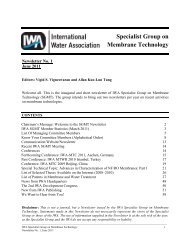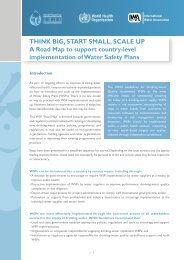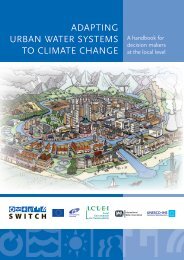Sanitation 21 planning framework - IWA
Sanitation 21 planning framework - IWA
Sanitation 21 planning framework - IWA
- No tags were found...
You also want an ePaper? Increase the reach of your titles
YUMPU automatically turns print PDFs into web optimized ePapers that Google loves.
<strong>Sanitation</strong> <strong>21</strong>There is rarely much concern for the widerenvironment of the city or downstream areas.Where competent utilities are operating and thereis a history of environmental management, thissimply translates into household willingness topay (usually through a sewerage ‘cess’ – a tax orfee) for the utility to ‘take care’ of downstreamissues. Where there is no ‘trusted’ or competentutility provider this translates into households orneighbourhoods discharging wastes downstreamto contaminate the next quarter of the city or town(see Figure 3 on previous page) .2.2.2 The Utility manager’s focus on theexternal environment and financeBy contrast service providers, often utilities, mayhave a focus on water management rather thansanitation provision, resulting in a particular focuson networked solutions. Even where utilities orservice providers focus on alternative sanitationoptions external drivers such as environmentallegislation, regulation or technical norms andstandards may result in decisions which donot take household interests fully into account.Financial structures which steer investmentsfrom national to local governments may alsohave a bigger impact on investment decisionsthan household needs. Furthermore techniciansmay sometimes concentrate on designing themost efficient and technically elegant solution.These institutional constraints are significant andseem disproportionately to result in a decision tobuild a wastewater treatment plant. This, in turndetermines the selection of the collection system This diagram is taken from the DFID Guidance Manual onWater Supply and <strong>Sanitation</strong> Programmes LSHTM/WEDC 1998.Section 2 of the guide provides and excellent summary of thehealth-analysis which drives much sanitation decision making andhas contributed to the thinking about this <strong>framework</strong>.(usually a sewerage network), the layout fortrunk sewers and hence local technical choicesfor collection further upstream. Finally, at thehousehold domain, options have been narrowed tothe use of a water closet and a sewer connection,with all their associated financial implications.Many poorer households or those without waterconnections are automatically excluded. Ininformal settlements where the utility cannot or willnot construct sewers the result is no connectionand no service. Thus it happens that the utility/city may have met a set of reasonable criteria andconnected hardly anyone.2.2.3 The Resulting GapThus investments made at one ‘end’ of thesystem may have neutral or even negativeimpacts at the other end. Left without accessto sewerage, households or communities mayinvest in local solutions (onsite pit latrines, localinformal sewerage etc) which, since they are notofficially recognised as part of the system, are atbest unregulated with pit wastes and effluents forexample being ‘dumped’ on downstream areas.Meanwhile utilities who invest heavily in expensivereticulated sewerage and costly wastewatertreatment systems may seek to raise tariffs to offsetthese investments, or may charge high connectionfees, or may exclude households who live ininformal unplanned settlements from connecting– thus creating multiple barriers to householdsaccessing an ‘improved service.Alternatively utility managers may decide toencourage and support the development ofon-site systems but fail to put in place sludgemanagement strategies.Box 3: Kibera – People in the WayIn Kibera, Nairobi almost a million people reside in an unplanned and technically illegal settlement, manyhouseholds have constructed rudimentary pits and many people make a living emptying them. Furthermore Kiberaresidents have consistently resisted removal and redevelopment efforts and represent a potent political force inthe city. Nonetheless the city master plan depends on a network of trunk sewers, some passing through an areaof well-planned housing right where Kibera lies today. Since these trunk sewers are a key element of the Nairobisanitation system Kibera effectively prevents the development of the ‘ideal’ solution. As a result utility investmentsin sanitation for Kibera are more or less stalled despite goodwill on all sides to improve the situation.– 11 –
















